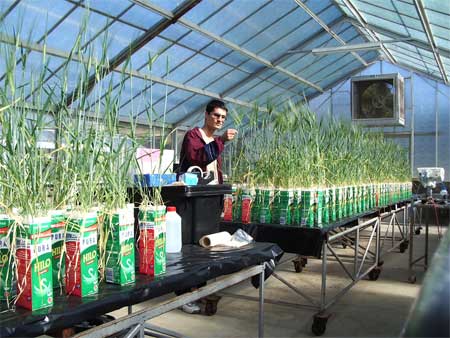Western Australia
April 16, 2008
 Chromosomal
regions conferring zinc efficiency in barley, recently
identified by three WA researchers, could have important
implications for improving the zinc status of the human diet. Chromosomal
regions conferring zinc efficiency in barley, recently
identified by three WA researchers, could have important
implications for improving the zinc status of the human diet.
Behzad Sadeghzadeh (photo), PhD student and Professor Zed
Rengel, both of the School of Earth and Geographical Sciences,
Faculty of Natural and Agricultural Sciences (FNAS) at
The University of Western
Australia (UWA), worked with Dr Chengdao Li from the
Department of Agriculture and Food WA (DAFWA) on the project.
Professor Rengel said the discovery of genetic markers
contributing to improved barley productivity and nutritional
quality in zinc-deficient environments is promising because as
an essential trace element for humans, zinc has a crucial role
in more than 300 enzymes in the human body.
According to Professor Rengel, zinc is vital for physical and
mental development, fertility, vision and resistance to
infections, yet many of the world’s soils and therefore foods
are zinc-deficient.
“Zinc deficiency is a problem in many developing countries and
is the fifth leading cause of diseases, especially diarrhoea and
pneumonia in children.”
 Mr
Sadeghzadeh, whose PhD is supported by the Government of Iran,
discovered that some barleys grow and yield well, even in
zinc-deficient soils, because they are zinc efficient and have
zinc-dense seed. Mr
Sadeghzadeh, whose PhD is supported by the Government of Iran,
discovered that some barleys grow and yield well, even in
zinc-deficient soils, because they are zinc efficient and have
zinc-dense seed.
A doubled-haploid population of 150 barley lines derived from a
cross between a zinc-inefficient Australian cultivar, ‘Clipper’
and a zinc-efficient Algerian wild barley, ‘Sahara 3771’, were
screened for seed zinc content under field conditions at UWA’s
Shenton Park Field Research Station.
Comprehensive molecular mapping of doubled-haploid populations,
using 302 markers, enabled Mr Sadeghzadeh to identify
quantitative trait loci for zinc accumulation in barley seed.
“Two regions on chromosome 2H in barley associated with zinc
concentration and content in seed could explain 45 per cent and
59 per cent of the total variation in the seed zinc
concentration and content, respectively,” he said.
“Identifying molecular markers linked to genetic loci
controlling seed zinc will allow more rapid and efficient
screening of barley lines than traditional techniques.
“By selecting lines with zinc-dense seed, barley breeders will
be able to produce cultivars that yield better in zinc-deficient
soils and also contribute required amounts of zinc to the human
diet,” Mr Sadeghzadeh said. |
|